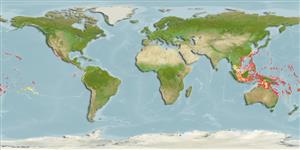>
Gobiiformes (Gobies) >
Gobiidae (Gobies) > Gobiinae
Etymology: Eviota: No etymology given, suggested by Christopher Scharpt: from Latin 'eu' for 'true' and 'iota' for anything very small, in combination 'truly very small' referring to it as being the smallest vertebrate at the time it has benn described by Jenkins (thus, making the suggestion by Scharpt plausible..
More on authors: Jordan & Seale.
Environment: milieu / climate zone / depth range / distribution range
Ekologi
laut berasosiasi dengan karang; kisaran kedalaman 0 - 40 m (Ref. 107299). Tropical; 30°N - 30°S
Western Pacific: Japan (Ryukyu and Ogasawara islands), Taiwan, the Philippines and south to Australia and Norfolk Is.; east to Vanuatu, Fiji, Wallis and Futuna, Tonga and Samoa, including Palau, Guam and Marshall Islands in Micronesia.
Size / Weight / umur
Maturity: Lm ? range ? - ? cm
Max length : 2.3 cm SL jantan/; (Ref. 1602)
deskripsi pendek
Kunci identifiaksi (pengenalan) | Morfologi | Morfometrik
Duri punggung (Keseluruhan (total)) : 7; duri punggung lunak (Keseluruhan (total)) : 8 - 9; Duri dubur: 1; Sirip dubur lunak: 7 - 8. This species is distinguished by the following characters: complete cephalic sensory-canal pore system (pattern 1); the fifth pelvic-fin ray 10-40% (usually 20%) of fourth ray; some pectoral-fin rays are branched; dorsal/anal-fin formula 9/8; presence of a prominent occipital spot; dorsal midline of body with a series of small dark spots along the dorsal-fin bases; dark bars present crossing the nape in advance of dorsal fin; caudal-peduncle depth 13.4-14.9% SL (Ref. 107299).
Inhabits shallow waters, often including tide pools of exposed seaward reefs (Ref. 37816, 116739), usually in high-tide splash zones and at shallow depths (Ref. 107299).
Life cycle and mating behavior
Maturities | Reproduksi, perkembang biakan | Spawnings | Egg(s) | Fecundities | Larva
Myers, R.F., 1991. Micronesian reef fishes. Second Ed. Coral Graphics, Barrigada, Guam. 298 p. (Ref. 1602)
Status IUCN Red List (Ref. 130435)
ancaman kepada manusia
Harmless
penggunaan manusia
Perikanan: tidak ada kepentingan
Alat, peralatan
laporan khas
muat turun XML
Sumber internet
Estimates based on models
Preferred temperature (Ref.
123201): 24.7 - 29.3, mean 28.3 °C (based on 1537 cells).
Phylogenetic diversity index (Ref.
82804): PD
50 = 0.5000 [Uniqueness, from 0.5 = low to 2.0 = high].
Bayesian length-weight: a=0.01023 (0.00477 - 0.02194), b=3.02 (2.84 - 3.20), in cm total length, based on LWR estimates for this (Sub)family-body shape (Ref.
93245).
Trophic level (Ref.
69278): 3.1 ±0.3 se; based on size and trophs of closest relatives
Daya lenting (Ref.
120179): Tinggi, Waktu penggandaan populasi minimum kurang dari 15 bulan (Preliminary K or Fecundity.).
Fishing Vulnerability (Ref.
59153): Low vulnerability (10 of 100).
Nutrients (Ref.
124155): Calcium = 374 [160, 1,182] mg/100g; Iron = 1.74 [0.76, 3.78] mg/100g; Protein = 18 [16, 20] %; Omega3 = 0.175 [0.057, 0.516] g/100g; Selenium = 33.1 [10.6, 89.5] μg/100g; VitaminA = 121 [25, 572] μg/100g; Zinc = 4.49 [2.47, 7.46] mg/100g (wet weight);
